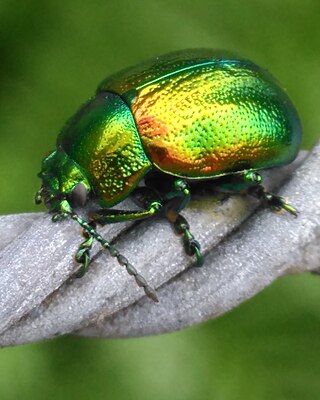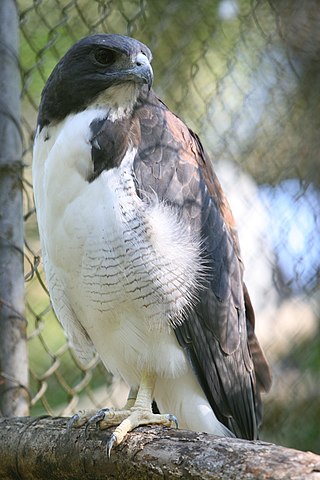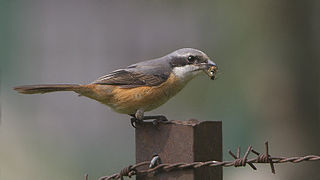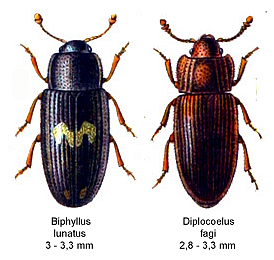
The white-winged tern, or white-winged black tern, is a species of tern in the family Laridae. It is a small species generally found in or near bodies of fresh water across much of the world, including Europe, Africa, Asia, and Australia. The genus name is from Ancient Greek khelidonios, "swallow-like", from khelidon, "swallow".

The black guillemot or tystie is a medium-sized seabird of the Alcidae family, native throughout northern Atlantic coasts and eastern North American coasts. It is resident in much of its range, but large populations from the high arctic migrate southwards in winter. The bird can be seen in and around its breeding habitat of rocky shores, cliffs and islands in single or smalls groups of pairs. They feed mainly by diving towards the sea floor feeding on fish, crustaceans or other benthic invertebrates. They are listed on the IUCN red list as a species of least concern.

The rufous-tailed scrub robin is a medium-sized member of the family Muscicapidae. Other common names include the rufous scrub robin, rufous bush chat, rufous bush robin and the rufous warbler. It breeds around the Mediterranean and east to Pakistan. It also breeds south of the Sahara from the Sahel region east to Somalia; these African birds are sometimes considered to be a separate species, the African scrub robin. It is partially migratory, wintering in Africa and India. This is a very rare visitor to northern Europe.

The Tansy beetle is a species of leaf beetle. The common name derives from its main foodplant, Tansy, but it can also use other wetland plants such as Gypsywort and Water Mint. It measures 7.7–10.5 mm in length and has a characteristic bright metallic green colouration, with pitted elytra and a coppery tinge. In addition to the nominotypical subspecies, which repeats the specific name, C. graminis graminis, there are five further distinct subspecies of Tansy beetle, which, collectively, have a Palearctic distribution, although in the majority of countries where it is found the species is declining. In the United Kingdom it is designated as 'Nationally Rare'. The stronghold population here is located along the banks of the river Ouse in York, North Yorkshire. Other, small, fenland populations exist at Woodwalton Fen and at Welney Wildfowl and Wetlands Trust (WWT) reserve.

Lucy's warbler is a small New World warbler found in North America. This species ranges includes southwestern United States and northwestern Mexico. It is one of only two warblers to nest in cavities.

Thymelicus lineola, known in Europe as the Essex skipper and in North America as the European skipper, is a species of butterfly in the family Hesperiidae.

The brown hairstreak is a butterfly in the family Lycaenidae. The range includes most of the Palaearctic.

The brant or brent goose is a small goose of the genus Branta. There are three subspecies, all of which winter along temperate-zone sea-coasts and breed on the high-Arctic tundra.

The slaty-headed parakeet is the only psittacid species to exhibit altitudinal migration. The species' range extends from Pakistan, to Western Himalayas in India through Nepal and Bhutan and up to the Eastern Himalayas in the northeastern Indian state of Arunachal Pradesh. They descend to the valleys in winter, approximately during the last week of October.

The white-tailed hawk is a large bird of prey species found in tropical and subtropical environments of the Americas.

The scarlet dragonfly is a species of dragonfly in the family Libellulidae. Its common names include broad scarlet, common scarlet-darter, and scarlet darter.

The Mexican deer mouse is a species of forest-dwelling rodent in the family Cricetidae. It is found in southern Mexico and throughout much of Central America.

The grey-backed shrike is a bird in the family Laniidae inhabiting South-east Asia.

The beautiful woodpecker is a species of bird in subfamily Picinae of the woodpecker family Picidae. It is endemic to Colombia.

Biphyllidae, or false skin beetles, are a family of beetles, in the superfamily Cleroidea. They have a cosmopolitan distribution. About 195 species are known. They live under the bark of dead trees and in leaf litter, and are mycophagous, feeding on fungi.

Leptostylopsis annulipes is a species of longhorn beetles of the subfamily Lamiinae.

Biphyllus is a genus of beetles in the family Biphyllidae, containing the following species:

Hydaticus pacificus, is a species of predaceous diving beetle found in South and South East Asia.
Thaumaglossa pici, is a species of skin beetle found in Sri Lanka.
Jauravia albidula, is a species of lady beetle endemic to Sri Lanka.


















